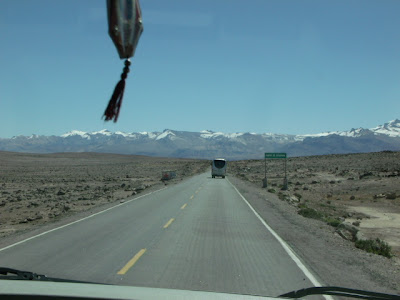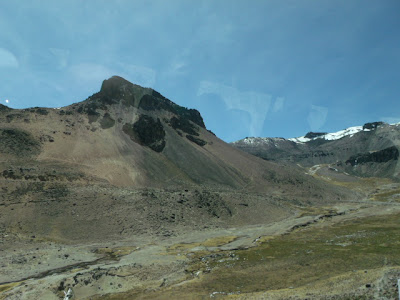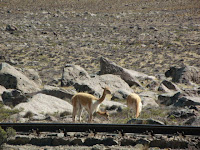On our night in the Colca Canyon (July 29th), we stayed in the town of Cabanaconde, which is the seat of the district of the same name, in Arequipa's Caylloma province.
Beside condors, Cabanaconde is known for the exquisitely embroidered traditional clothing worn by its women. It contrasts from the also highly decorated clothing of the women of Chivay in that the latter employ apliques of sequins and beads to achieve the decoration while Cabanaconde women exclusively use embroidery.
There is also a legend related to Cabanaconde that concerns the Incas. It seems that the Inka Mayta Capac arrived one day with an "army" and built terraces in the valley. There, this "army" build terraces and planted corn at various levels, and once it had sprouted, departed, ordering the local Cabana people to not touch the crop until the Inka's return.
Seven years passed until Mayta Capac returned with another "army", this time of farmers, who harvested the ears. The corn had in the intervening years differentiated itself into seven varieties adapted to different conditions in the valley, and thus gave rise to the Cabanaconde corn, which is famed for its quality throughout the south even today.
 |
| Part of the view from our hotel |
 | |
| Ruins of an old private chapel, as seen from the hotel balcony |
We spent the night at the Hotel Kuntur Wassi, a place of somewhat ecclectic-seeming design, but friendly service and good food - I had a terrific lomo saltado there (and if you recall what I said previously about eating lomo saltado out you'll understand that this was quite something) and we were treated to a welcoming cocktail, and an after-dinner digestif from a selection of cane liquor macerated with Andean and Amazonian herbs.
An interesting feature of our night there was that the beds were dressed with thick hand-woven wool yarn blankets and the air was so dry and the static electricity so strong up there that in the middle of the night's darkness sparks would flash whenever one rolled over in bed!
It was nice to fall asleep to the baah'ing of the sheep next door and the hee-haw'ing of the donkeys across the way.
Cabanaconde lies near the western, downstream, end of the Colca Canyon and across the valley from the western flank of Bomboya mountain. The mountain is sadly in the Peruvian newsmedia a lot these days thanks to the disappearance four or five months ago of Lima university student, Ciro Castillo. His then girlfriend, Rosario Ponce, was found by rescuers after wandering alone on the mountain, she says, for nine days since she and Castillo argued and went their separate ways. Since the start there were questions raised about Ponce's testimony and the behaviour of the couple in the day, or days, previous to their purported separation. In any case, Castillo's dad has been roaming the mountain since, hoping to locate his son's body, Ponce has been tried in the media, and the case is the talk of the town throughout the the region.
We departed Cabanaconde early on the 30th of July, after a morning stroll and visit to the plaza.





















































